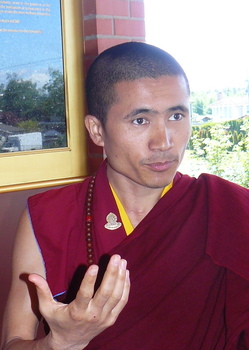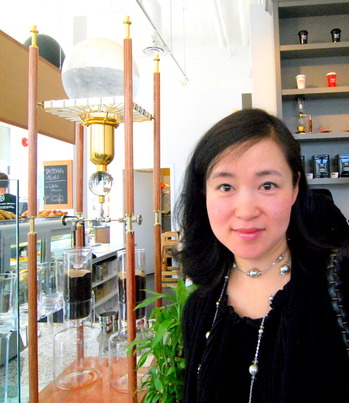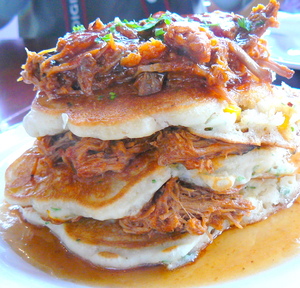The main Shrine Hall at Thrangu Monastery in Richmond, British Columbia
RICHMOND, BC--We're here at the height of hockey fever, and the Canucks failed to bring home the trophy. But it's okay. Really. A word of explanation:
In medieval Burgundy, the Cistercian monks--who knew how to read, so they understood the value of writing things down--came up with notion of identifying specific plots of grape vines, the beginnings of the modern system of appellations. And to this day, they make some of the best cheese in France, Cîteaux. We have come to expect that tireless devotion and unquestioning obediance (on the part of others) lead to something delicious (for us).
 Bhuddist monks, on the other hand, are under no obligation to "produce" anything. Their monasteries serve as a refuge for study, prayer and meditation (called, simply, "practice") undisturbed by worldly concerns. "In this way, monasteries serve as a means to accumulate wisdom," says 25-year-old Lama Rabjor Daw, the Thrangu Monastery's emissary to the outside world, and the only monk with a cellphone.
Bhuddist monks, on the other hand, are under no obligation to "produce" anything. Their monasteries serve as a refuge for study, prayer and meditation (called, simply, "practice") undisturbed by worldly concerns. "In this way, monasteries serve as a means to accumulate wisdom," says 25-year-old Lama Rabjor Daw, the Thrangu Monastery's emissary to the outside world, and the only monk with a cellphone.Thrangu is the first traditional Tibetan monastery in the northwest of North America. It was founded last year by the Very Venerable Thrangu Rinpoche ("Precious One"), who, in addition to his role as a spiritual leader, is also among the foremost scholars of Buddhism. When he visits the monastery, he doesn't deliver sermons; he comments on and interprets holy texts.
A young Tibetan monk named Karma Dradu, 32 years old at the time, designed and executed all the decoration. The centerpiece of the sanctuary is a 16-foot, gold-plated statue of the Shakyamuni Buddha, flanked by 35 Buddhas of Confession and 500 Medicine Buddha statues.
The rationale for a monastery in British Columbia, according to the website: "to help spread the genuine Dharma in many lands, thus quelling the misfortunes of epidemics, famine and war in this world and helping peace, education, and prosperity to flourish." Sounds like the thrills of winning the Stanley Cup will have to wait here, as well.
Lama Rabjor, the one with the cell phone and keys, says it's important to welcome tourists, to show the public what Buddhism is all about. He betrays none of the impatience or defensiveness one might expect of a young man in his 20s. No less important, of course, is to serve the tens of thousands of Buddhists who now live in the Vancouver area.
The monastery's resident monks and the occasional visitor live in simple rooms (indoor plumbing, but no TV). So there wouldn't be any temptation to watch to hockey. The monks are vegetarians, of course; the pleasrue of food is not part of their lives. That barbecue in the courtyard? It's for a ceremonial fire, nothing more.
Thrangu Monastery, 8140 No. 5 Road, Richmond BC
Our visit to Richmond was sponsored by Tourism Richmond.






